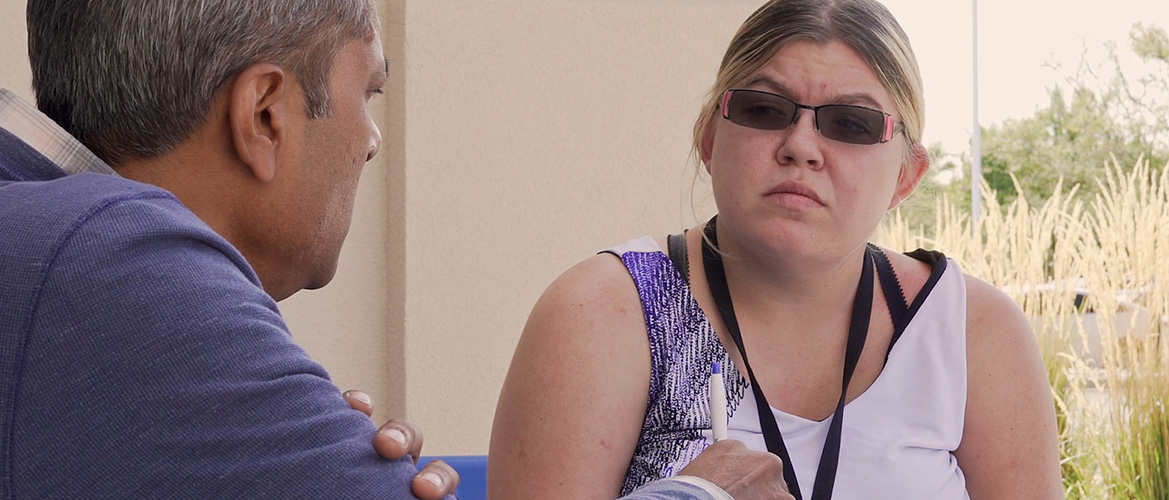Hospitals were a frequent stop for Shakil Davis every time he tried to quit drinking.
The Albuquerque accountant sought relief from emergency rooms when unbearable withdrawal symptoms took hold — severe nausea, anxiety and a pounding heart rate.
The ER was his go-to health care provider until his frequent visits there led him to Shelby McDaniel, a recovery support assistant for Blue Cross and Blue Shield of New Mexico. She connects Medicaid members to resources they need to begin recovery and helps them stay on track.
"She came to meet me at the hospital,” Davis, 44, recalls. She simply asked how she could support him in his recovery. “It built up my trust. It is not just about health insurance. There’s more to it.”
McDaniel routinely meets members like Davis, who repeatedly seek emergency room care when facing a substance use or mental health crisis. She attempts to encounter members when they are most vulnerable — and possibly most willing — to embrace intervention, especially from someone who’s been in a similar situation.
As a state-certified peer support specialist, McDaniel’s experience with mental illness, homelessness and recovery uniquely qualifies her to understand and empathize with members as she helps them gradually loosen the grip their disorders hold on them. Her success hinges on a special blend of patience and persistence because many members, skeptical of her intentions, resist the help.
"I try to put myself in their shoes when I was in my dark place in my recovery,” McDaniel says of her approach with members. “I didn’t want somebody to give up on me. My members don’t want me to give up on them.”
Increased engagement, decreased ER use
Emergency rooms long have been the primary health care source for many patients with substance abuse disorders and mental illness. About 1 in 8 ER visits involves a mental illness or substance use disorder, according to research by the U.S. Department of Health and Human Services. Emergency room visits for alcohol and substance use disorders jumped about 75% between 2006 and 2014.
However, after treating patients, hospitals may discharge them without providing services or referrals for follow-up outpatient care or treatment. So, another mental health or substance use crisis leads to another trip to the emergency room.
This pattern inspired hospitals and other health care organizations nationwide to create programs involving peer coaches and advocates. Drawing on their own experiences, these supporters can establish strong connections with patients and guide them toward long-term solutions.
Two years ago, Blue Cross and Blue Shield of New Mexico started its peer support program after finding almost a third of emergency room visits by its Medicaid members were related to substance use and mental illness.
"A lot of times they don’t understand that there are alternatives,” says Russ Liles, manager of the New Mexico Plan’s clinical business solutions. “They’ve used emergency rooms as their sources of care for years. It’s not a good way to access care.”
So far, emergency room visits have plummeted almost 70% among the program’s participating members. Additionally, the number of those members readmitted to hospitals within 30 days of receiving care have dropped more than 50%. Other Blue Cross and Blue Shield plans, including Illinois’, want to replicate New Mexico’s program because of its success.
Finding ER alternatives
Blue Cross and Blue Shield of New Mexico employs more than 20 recovery support specialists statewide to help Medicaid members grappling with substance use disorders and mental illnesses. A computer system in hospitals throughout the state, called the Emergency Department Information Exchange (EDIE), notifies their supervisor, Jeri Hollan, after a member arrives seeking care for substance use disorder or mental illness.
Hollan uses those notifications to narrow down members who have sought emergency room care between two and eight times in one month. She then dispatches a specialist, who tries to get to the ER before the member leaves, which can improve intervention success.
"It’s all about engagement,” Liles says. “If we can get the engagement piece down, our chances go way up that they’ll be willing to work with us and let us help them. If we can form that relationship, then they’re more willing to give us a good phone number or answer the phone when we call.”
Once a member agrees to accept assistance, McDaniel and her colleagues can help them find doctors, housing and other resources — whatever they believe will help them begin recovery and stay out of the hospital.
“I was like our members. I was in the ER a few times a week. Many of us have that in common,” Hollan says. “We were seeking emergency services sometimes because we needed to. Other times, because there wasn’t anywhere else to go, or family didn’t know what to do with us. When you share that with somebody, when you have that experience, that barrier just starts to drop.”
Continuous outreach
Davis is among about 80 members McDaniel supports in addition to any new emergency room referrals she receives. Some members require more contact than others, depending on their needs.
“It’s just continually a lot of outreach,” she says. “You can’t force anything on someone. Every day, I meet with a member, it’s meeting them where they’re at (in recovery) that day. It can change from day to day.”
After months of working together, Davis says McDaniel has given him the encouragement, hope and belief in himself to set goals, such as starting a business, and achieve them. He credits her with changing his life.
“I only had to show willingness to be a part of recovery,” Davis says. “Shelby (McDaniel) never discouraged me or reminded me of my past. She would always be there. She still is there whenever I call her.”

